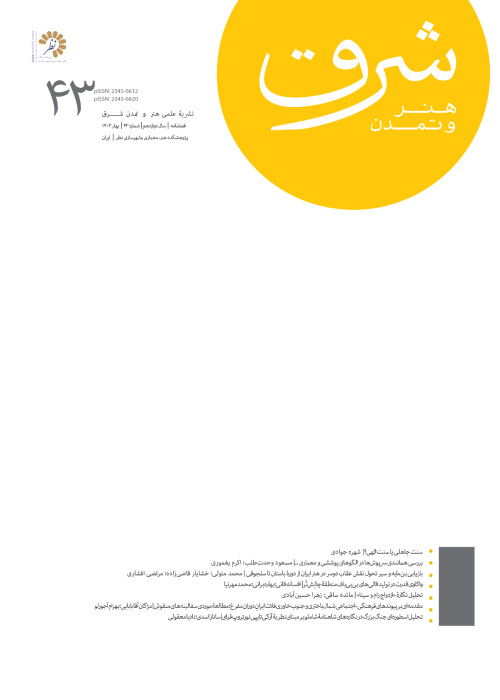Analyzing Power in the Production of Bibi-Baf (Bibi woven) Rugs in the Chaleshtor Region
Author(s):
Article Type:
Research/Original Article (دارای رتبه معتبر)
Abstract:
Carpet weaving stands as one of Iran’s most authentic traditional arts. Studying and scrutinizing this art reveals the existence of power structures, sometimes ruthless, hidden behind its beautiful and captivating facade, playing significant roles in its zenith and decline. The region of Chaleshtor, nestled within the precincts of Chaharmahal and Bakhtiari province in the realm of Iranian carpet geography, is replete with discursive occurrences that, only under the auspices of attention to the hypertext, structure, and context, can be subject to analysis; particularly, a group of influential women known as ‘the Bibis’ wielded a remarkably influential role as a microphysic of power in the production of Bibi Baf rugs. Microphysics of power constitutes small currents and minute powers that permeate and reproduce bureaucratic, disciplinary, and psychological forms within smaller, concealed strata of society. During the Qajar era, microphysics of power played a significant role in political and social transformations. The power of Bakhtiari women in Chaleshtor, akin to the power of court women, became the primary factor in creating and producing a distinct genre of carpet in this region, known by the very name of ‘Bibi Baf’ rugs, renowned for their significance. The most notable characteristic of these rugs crafted at the behest of the Bibis was their incorporation of cultural and political transformations along with conceptual and discursive formulations within themselves. Investigating the role of the Bibis as a microphysics structure in Bibi Baf rugs is the subject of this study, aiming to explore and examine the genesis of the Bibis’s micro power by scrutinizing the ongoing political factors in the Bakhtiari women’s power system, subsequently assessing and elucidating the constructive role of Bibi Baf as a power institution in carpet production under study. Hence, the principal research question emerges: How has the power of the Bibis influenced the production of rugs known as Bibi Baf? This inquiry, based on theoretical foundations and Michel Foucault’s notions of power, delves into the transformations of Bibi Baf rugs in the context of power-resistance, power-knowledge, and power-relationship under the Foucauldian power discourse. The contemplative conclusion drawn unveils that the economic, political, and managerial power of the Bibis constituted one of the most influential factors shaping these types of rugs.
Keywords:
Power , Microphysics , the Bibis , Bibi Baf Rugs , Foucault
Language:
Persian
Published:
Journal of Art and Civilization of the Orient, Volume:12 Issue: 43, 2024
Pages:
30 to 41
magiran.com/p2701521
دانلود و مطالعه متن این مقاله با یکی از روشهای زیر امکان پذیر است:
اشتراک شخصی
با عضویت و پرداخت آنلاین حق اشتراک یکساله به مبلغ 1,390,000ريال میتوانید 70 عنوان مطلب دانلود کنید!
اشتراک سازمانی
به کتابخانه دانشگاه یا محل کار خود پیشنهاد کنید تا اشتراک سازمانی این پایگاه را برای دسترسی نامحدود همه کاربران به متن مطالب تهیه نمایند!
توجه!
- حق عضویت دریافتی صرف حمایت از نشریات عضو و نگهداری، تکمیل و توسعه مگیران میشود.
- پرداخت حق اشتراک و دانلود مقالات اجازه بازنشر آن در سایر رسانههای چاپی و دیجیتال را به کاربر نمیدهد.
In order to view content subscription is required
Personal subscription
Subscribe magiran.com for 70 € euros via PayPal and download 70 articles during a year.
Organization subscription
Please contact us to subscribe your university or library for unlimited access!



